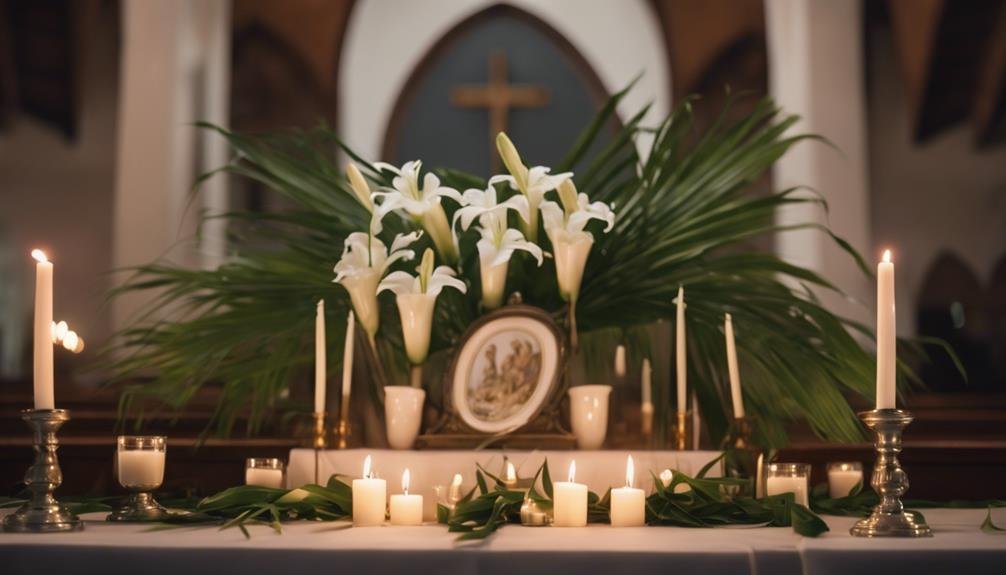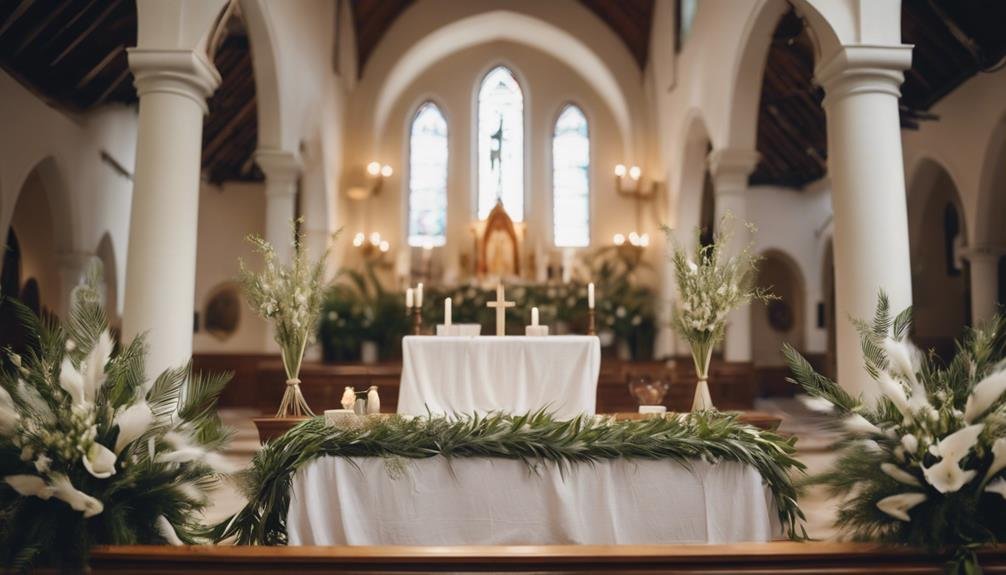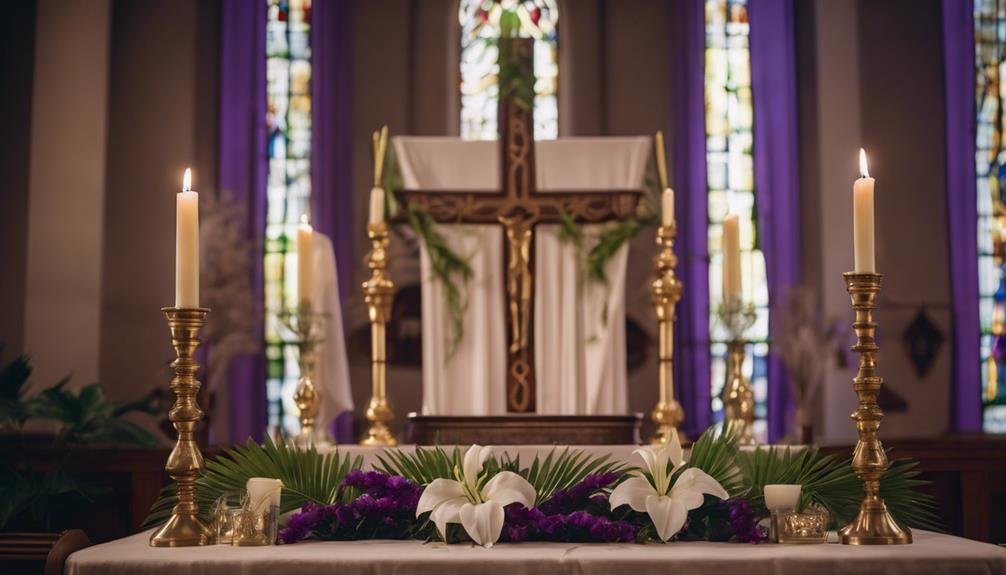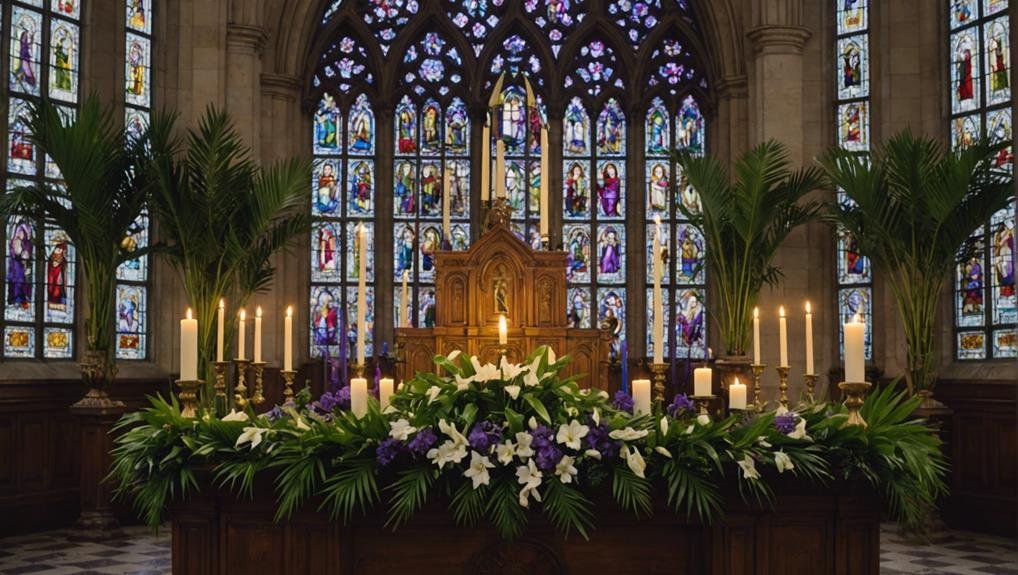When preparing for Palm Sunday, you might wonder about the importance of decorating your church’s altar to reflect the deep spiritual significance of the day. Incorporating elements like palm branches symbolize Jesus’ triumphant entry into Jerusalem, while purple cloth hints at the coming passion.
Ensuring a balance between aesthetics and symbolism is crucial, ensuring each piece contributes to a reflective atmosphere. Have you considered the impact of lighting and the strategic placement of candles to enhance this sacred space?
Let’s explore how these elements can transform your altar, creating an environment that resonates with congregants and invites a deeper sense of reverence.
Key Takeaways
- Incorporate palm branches around the altar to symbolize peace and victory.
- Use a purple cloth to cover the altar, enhancing the occasion’s solemnity.
- Display olive branches or peace doves to emphasize themes of peace and reconciliation.
- Arrange seasonal flowers and candles to create a visually appealing and thematic environment.
- Position icons and statues strategically for visibility, ensuring they contribute to the spiritual significance of the service.
Significance of Palm Branches

Palm branches hold deep symbolic meaning, representing peace and victory as you celebrate Palm Sunday. The historical origins of this tradition trace back to the Gospel narratives where Jesus enters Jerusalem, greeted by crowds waving palm branches, symbols of triumph and spiritual victory in ancient cultures.
This moment, known as the Triumphal Entry, marks the beginning of Holy Week in Christianity, culminating in Easter Sunday.
Over time, cultural variations have influenced how different communities observe this day. In some places, not only palm branches but also branches from olive trees or other local foliage are used during processions.
This adaptation reflects the availability of palms in various regions and incorporates local traditions and symbols into the celebration. As you prepare your altar with these branches, you’re not just decorating but connecting with a rich tapestry of faith and history that underpins this observance.
Each element on your altar carries centuries of meaning, adapted through generations to fit the congregation’s spiritual and cultural context. So, as you lay those palm branches, remember you’re part of a tradition that’s both ancient and ever-evolving, deeply rooted yet wonderfully diverse.
Using Purple Cloth Symbolically
Draping your altar with purple cloth can deeply enhance the solemnity and reverence of Palm Sunday. This tradition isn’t just about aesthetics; it’s deeply rooted in the symbolism and color psychology that purple brings to the sacred space.
As you choose your fabric, remember that each type adds a unique texture and depth to the environment, influencing the congregation’s spiritual experience.
When selecting purple cloth, consider the following aspects:
- Color Psychology: Purple is often associated with repentance, mourning, royalty, and dignity. This duality mirrors the complex emotions of Palm Sunday, reflecting both the celebration of Jesus’ arrival and the anticipatory sorrow of His coming passion.
- Fabric Types: Velvet can add a rich, tactile depth, enhancing the visual weight of the altar. With its reflective properties, Satin can subtly play with light, adding a dynamic quality to your setup. Linen, being more understated, offers a humble yet elegant backdrop suitable for the day’s reflective nature.
- Symbolic Placement: Arrange the cloth so it falls gracefully, perhaps pooling slightly at the base to symbolize the lavish anointing of Jesus that the day commemorates.
Floral Arrangements for the Altar

Incorporating floral arrangements into your altar setup greatly enhances the visual and spiritual ambiance of the service. By wisely selecting flowers that emphasize color symbolism, you can decorate and deepen the congregation’s experience of Palm Sunday’s profound themes.
When choosing flowers, consider the seasonal blooms available. Springtime offers many options that beautifully align with the themes of renewal and resurrection. Lilies represent purity and hope, making them a fitting choice for this celebration.
Regarding color symbolism, purple is traditionally associated with royalty and penitence, reflecting Jesus’s journey and the spiritual preparation for Easter. You might also think about white blossoms, like tulips or daisies, symbolizing peace and innocence.
Arrange these flowers thoughtfully around the altar. Perhaps create a central bouquet that draws the eye, flanked by smaller arrangements that echo the main theme.
This setup balances the altar’s appearance and reinforces the thematic undercurrents of Palm Sunday through visual storytelling. Remember, each element you choose carries a message, weaving a deeper narrative into the tapestry of worship.
Incorporating Candles and Lights
How can adding candles and lights elevate your Palm Sunday altar decorations? Integrating these elements enhances the visual appeal and deepens the spiritual ambiance of your space. When planning your altar, contemplate how lighting techniques and candle placements can transform the setting.
Candles create a focal point that draws attention. By strategically placing them around the altar, you can highlight specific areas and guide the congregation’s focus. For example, surrounding the altar with candles can symbolize the light of Christ entering Jerusalem, enhancing the thematic depth of your decorations.
Here are a few tips to ponder:
- Varied Heights: Use candles of different heights to add depth and interest. Staggering these can prevent the altar from looking flat and uniform.
- Color Coordination: Choose candles that complement the overall color scheme of your decorations. Traditional colors like white and gold, which reflect purity and celebration, can be used.
- Safety and Practicality: Ensure the candle placements are safe and won’t pose a fire hazard. Consider using LED candles for a similar effect without the risks associated with open flames.
Incorporating these elements thoughtfully can create a serene and inviting atmosphere for your Palm Sunday celebrations.
Olive Branches and Peace Symbols

Incorporating olive branches and peace symbols into your Palm Sunday altar can greatly enhance the theme of peace and triumph. Historically recognized as symbols of peace, Olive branches bring a profound depth to the celebration.
When you arrange these branches around the altar, they serve as a visual reminder of the peace and reconciliation that Palm Sunday heralds. Additionally, integrating dove motifs can amplify this message.
You might consider placing small dove figures around the altar or using linen cloths embroidered with these symbols. Doves, often associated with the Holy Spirit, resonate deeply with themes of peace and new beginnings, reflecting the spiritual renewal that Palm Sunday represents.
Don’t forget to incorporate peace hymns into the service. These hymns can be a powerful auditory complement to your visual decorations. As the congregation sings about peace and redemption, the combined impact of the lyrics and the serene setting you’ve created will be truly moving.
This harmonious blend of symbols, music, and community participation makes the service a profound experience, reminding everyone of the core messages of this sacred day.
Crafting Palm Crosses
Crafting palm crosses for Palm Sunday offers a hands-on way to connect with the tradition and significance of the occasion. You’ll start by selecting the right palm fronds—long, pliable, and tear-free.
The process requires patience and skill, but you’ll find it immensely rewarding as these crosses transform your altar and deepen the worship experience. Here’s how you can go about it:
- Choosing the Right Palms: Opt for younger, greener fronds as they tend to be more flexible, which makes them easier to fold and less likely to break.
- Mastering Tying Techniques: Learn the basic knot and secure method to ensure your crosses hold their shape throughout the service. This might require practicing a few times to get it right.
- Considering Cross Sizes: Create a variety of sizes to add visual interest and accommodate different spaces on the altar. Small crosses can be used for individual prayer cards, while larger ones make a striking central display.
Altar Layout and Design

Once you’ve crafted your palm crosses, it’s time to arrange them effectively on the altar. Considering the altar dimensions is essential, as this will guide you in creating a balanced and harmonious display. You don’t want your decorations to overwhelm the space or seem too sparse.
Start by measuring the altar’s length and width. This will help determine how many palm crosses you can place without overcrowding. Ideally, you’ll want a central larger arrangement flanked by smaller ones, maintaining visually pleasing and traditional symmetry.
Next, think about the seasonal colors appropriate for Palm Sunday. Shades of green are most suitable, symbolizing new life and the beginning of Holy Week.
You could enhance this with subtle splashes of gold or white, representing joy and purity, respectively. Integrate these colors through elements like cloth drapes or ribbons, ensuring they complement rather than dominate.
Arrange your palm crosses and color-coordinated decorations with the altar’s architecture in mind. If there’s a central crucifix or a prominent feature, align your main decoration to accentuate this focal point. You aim to create a sacred and celebratory setting, inviting all who come to worship.
Selecting Icons and Statues
Choosing the right icons and statues can often enhance the spiritual ambiance of your Palm Sunday altar. When selecting these pieces, it’s important to consider their aesthetic appeal and spiritual significance.
You’ll want to ensure that each icon and statue reflects the solemnity and joy of Palm Sunday, which represents Jesus’ triumphant entry into Jerusalem.
Icon placement is vital. It would help if you positioned icons so they’re visible to everyone in the congregation yet not so imposing as to distract from the overall service. Consider the sight lines from different areas in the church and place icons accordingly.
Statue restoration might also be necessary. Over time, statues can deteriorate or lose their luster, diminishing their impact. Before Palm Sunday, check your statues for any wear or damage. Restoring these statues not only preserves them but also enhances the spiritual and aesthetic value they add to your altar:
- Inspect for damage: Look for cracks, chips, or fading that may need repair.
- Clean gently: Use soft cloths and appropriate cleaners to avoid further damage.
- Consult professionals: Consider hiring experts specializing in religious artifacts for significant restoration.
Incorporating Incense

Incorporating incense into your Palm Sunday service adds a sensory depth that enhances the worship experience. The right incense types and scent selection can profoundly impact the atmosphere, helping the congregation connect more deeply with the day’s significance.
When choosing incense, consider Palm Sunday’s theme of renewal and triumph. You’ll want scents that uplift and inspire.
Frankincense is popular because of its sweet, warm aroma, symbolizing prayer and divine presence. Myrrh, another traditional option, offers a more earthy, calming scent, reminding us of the sacrificial aspects of faith.
Here’s a quick guide to help you choose:
| Incense Type | Scent Description |
|---|---|
| Frankincense | Sweet and warm, it enhances spirituality |
| Myrrh | Earthy and calming, it represents sacrifice |
| Sandalwood | Rich and woody, it promotes mental clarity |
| Rose | Floral and soothing, it symbolizes love and purity |
You’ll also want to make sure the incense is burned safely. Use a proper censer or thurible and place it where it enhances the service without overwhelming attendees. The goal is to complement, not dominate, the sensory experience of your Palm Sunday decorations.
Preparing the Communion Table
Preparing the communion table for Palm Sunday involves selecting the right elements to reflect the solemnity and celebration of the occasion. You’ll need to consider the setup’s spiritual significance and visual harmony.
Start with the linen selection; it’s not just a mere backdrop. Choose fine white linens to symbolize purity and joy, which are perfect for Palm Sunday. Make sure they’re immaculately ironed and draped gracefully over the table.
Next, focus on the chalice placement. This is central not only in position but also in its role during communion. Place the chalice at the center of the table, slightly forward, to signify its importance.
If used, surround it with the paten and ciborium, ensuring they’re equally accessible but not overshadowing the chalice. Take into account these points as you prepare:
- Linen Quality: Opt for high-quality linens that reflect the sanctity of the event.
- Symbolic Decor: To tie in the Palm Sunday theme, incorporate small palm branches around the base of the chalice.
- Lighting: Ensure the area around the communion table is well-lit, highlighting the elements while creating a respectful atmosphere.
Conclusion
As you plan your Palm Sunday altar decorations, remember the importance of each element. Palm branches signify victory, while purple cloth highlights the solemnity of the season.
Floral arrangements and candles add beauty and light, enhancing the sacred space. Don’t forget the peace symbolized by olive branches and the spiritual depth added by carefully selected icons and statues.
Finally, incorporating incense and preparing the communion table will complete your setting, making it a respectful and celebratory focal point for worship.
Suggested Articles:
Palm Sunday Blessings: Inspiring Quotes for a Sacred Journey
What Are the Best Family-Friendly Sunday Celebrations?
10 Best Sunday Church Services for a Joyful Gathering

